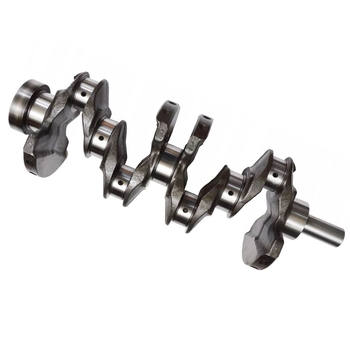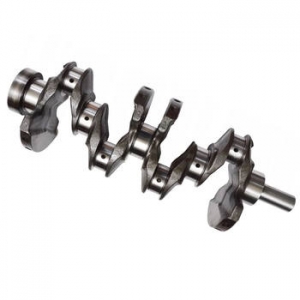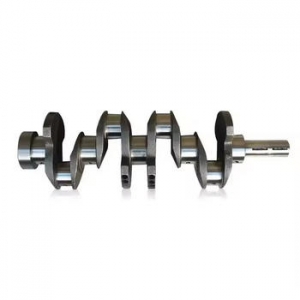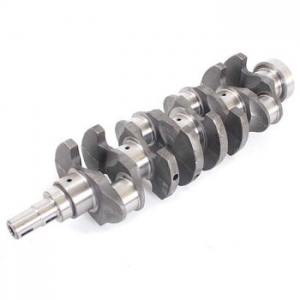At the heart of every engine, transferring the explosive power generated in the combustion chambers into rotational energy, lies the crankshaft. It's arguably the most stressed component, enduring immense forces with every revolution. For standard applications, many crankshaft materials and manufacturing processes suffice. However, when chasing serious horsepower, pushing RPM limits, or building engines for demanding environments like professional motorsport or heavy-duty industrial use, the requirements escalate dramatically. The forces involved can bend, twist, or even fracture lesser materials. This is where the discussion inevitably turns to components engineered for extreme resilience, and specifically, the unparalleled performance offered by a high-quality billet crankshaft 4340 steel. Understanding why this particular combination of material and manufacturing method stands out is crucial for anyone serious about building a reliable, high-output engine. It’s not just about adding power; it’s about ensuring the foundational components can handle that power consistently and reliably over time. Have you ever wondered what separates a championship-winning engine from one that suffers catastrophic failure under pressure? Often, the answer lies within its core, beginning with the crankshaft.
Understanding 4340 Steel: The Foundation of Strength
To appreciate the superiority of a **billet crankshaft 4340 steel**, we first need to understand the material itself. 4340 is a high-strength, low-alloy steel that contains chromium, nickel, and molybdenum. This specific composition gives it excellent toughness and strength, especially after it undergoes appropriate heat treatment. It's one of the most commonly used steels in aerospace and automotive applications where components are subjected to significant stress. Unlike more basic carbon steels, the alloying elements in 4340 significantly improve its hardenability and overall mechanical properties. This means that when heat treated correctly—typically involving quenching and tempering—it achieves a desirable balance of hardness, strength, and ductility. It can resist deformation and fracture under high loads, which is precisely what you need from a component experiencing the rapid acceleration and deceleration cycles of an internal combustion engine. Frankly speaking, selecting the right material is the absolute first step in creating a durable crankshaft, and 4340 steel provides a robust starting point that few other alloys can match when cost, workability, and strength are considered together.
The Specific Advantages of 4340 in High-Stress Applications
Digging a little deeper into why 4340 steel is so well-suited for the demanding environment inside an engine, it comes down to how its unique metallurgical properties translate into real-world performance. The presence of nickel imparts toughness, resistance to fatigue, and improved impact strength. Chromium contributes to hardenability and corrosion resistance, while molybdenum further enhances strength and toughness, especially at elevated temperatures, and helps prevent temper brittleness. When these elements work in concert within the 4340 matrix, the steel gains the ability to absorb and withstand repetitive high-impact loads and significant torsional stresses without suffering premature fatigue failure. For a crankshaft, which endures millions of stress cycles over its lifetime, this fatigue resistance is paramount. It's worth noting that while other materials might offer higher ultimate tensile strength, 4340's balanced properties, particularly its high yield strength and exceptional toughness, make it exceptionally resistant to the kind of bending and twisting forces a crankshaft encounters. Many experts agree that for high-performance engine components, 4340 steel strikes an optimal balance between cost, machinability, and mechanical performance.
Billet vs. Forged: A Critical Comparison for Crankshaft Performance
Beyond the material itself, the manufacturing process plays an equally critical role in determining a crankshaft's ultimate strength, reliability, and dimensional accuracy. The two primary methods for producing high-performance crankshafts are forging and machining from a solid billet. Forging involves shaping a heated steel blank through hammering or pressing, which aligns the material's grain structure along the shape of the crankshaft. This process can impart excellent fatigue strength in certain load directions due to the favorable grain flow. However, achieving complex shapes and tight tolerances with forging can be challenging, often requiring significant subsequent machining. Machining from a solid billet, on the other hand, starts with a homogenous block of steel, in our case, high-quality 4340. The entire crankshaft is then meticulously carved out using precision computer-controlled (CNC) machining. While this process doesn't inherently create the directed grain flow of forging, starting with a premium, homogenous material like 4340 steel minimizes the disadvantages, and the precision offered by CNC machining opens up possibilities simply not viable with traditional forging processes, especially when discussing billet crankshaft 4340 steel.
Why Billet Offers Unique Benefits for 4340 Steel
When you combine the inherent strength and toughness of 4340 steel with the precision of the billet machining process, you unlock distinct advantages. One of the most significant is the ability to create highly customized designs with intricate counterweight shapes and journal profiles optimized for specific engine requirements. This level of design freedom is much harder, sometimes impossible, to achieve consistently with forging, particularly in low-volume or bespoke applications. Furthermore, machining from a billet allows for extremely tight control over critical dimensions, surface finishes, and overall balance. This precision is absolutely essential for reducing friction, minimizing vibration at high RPMs, and ensuring consistent performance. Interestingly enough, while some argue for the grain structure advantage of forging, the meticulous quality control possible when starting with a verified homogenous block of 4340 steel and employing advanced machining techniques often results in a crankshaft with incredibly consistent properties throughout. This consistency is vital for long-term durability under punishing conditions, contributing significantly to the overall reliability and performance potential of a high-quality billet crankshaft 4340 steel.
The Manufacturing Journey: Creating a Billet 4340 Steel Crankshaft
The creation of a high-performance billet crankshaft from 4340 steel is a multi-step process demanding meticulous attention to detail at every phase. It begins with the selection of premium-grade 4340 steel bar stock, verified for its chemical composition and internal integrity. This bar stock is then roughly machined to a shape that begins to resemble the crankshaft. The crucial next step is heat treatment. The steel is heated to specific temperatures, quenched rapidly in oil or polymer to harden it, and then tempered at a carefully controlled lower temperature. This heat treatment cycle is paramount; it transforms the steel's microstructure, developing the optimal balance of hardness and toughness that defines the material's high-performance characteristics. Without proper heat treatment, the 4340 steel would not possess the required strength and durability. After heat treatment, the crankshaft undergoes precision finish machining using multi-axis CNC equipment. This is where the journals, rod pins, counterweights, and flanges are machined to their final, exact dimensions. The accuracy here directly impacts the engine's balance and bearing life. I've found that slight deviations at this stage can lead to significant issues down the road, underscoring the need for expert manufacturing.
Achieving Peak Performance Through Precision Engineering
Following the intricate machining process, several critical finishing steps are required to ensure the crankshaft is ready for the extreme demands of a high-performance engine. Pin and main bearing journals are precision ground and polished to achieve incredibly tight tolerances and a mirror-like surface finish. This surface finish is vital for minimizing friction and extending bearing life, especially under heavy loads and high RPMs. The crankshaft is then dynamically balanced. Because it is machined from a solid billet of 4340 steel, the inherent material consistency aids in achieving a very precise balance, which is fundamental to smooth engine operation, reduced vibration, and preventing harmonic issues that can damage components. Some crankshafts also undergo nitriding or other surface treatments after grinding to further enhance surface hardness and fatigue resistance in critical areas. Each of these steps, from the initial material selection and heat treatment of the 4340 steel blank to the final grinding and balancing, contributes directly to the superior strength, durability, and performance potential of a finished billet crankshaft 4340 steel. It's a process that requires specialized knowledge, advanced machinery, and unwavering quality control.
Unmatched Strength and Durability Under Extreme Loads
The culmination of using premium 4340 steel and employing precision billet manufacturing is a crankshaft with truly exceptional strength and durability. This combination results in a component capable of withstanding stress levels far exceeding those encountered by production-level crankshafts. In high-horsepower engines, the forces on the crankshaft can be staggering. Torsional loads from combustion pulses, bending loads from piston thrust, and tensile loads from inertia at high RPM all converge on this single component. A quality **billet crankshaft 4340 steel** is specifically engineered to absorb these forces repeatedly without yielding or fracturing. Its high yield strength means it resists permanent deformation under heavy load, and its exceptional fatigue strength allows it to endure millions of stress cycles common in racing or continuous heavy operation. This isn't just theoretical; in practical application, this translates to a crankshaft that won't flex excessively under power, maintaining critical bearing clearances and allowing the engine to produce peak power safely and reliably. For applications pushing the boundaries of internal combustion, the added strength provided by a 4340 billet design is not a luxury, but a necessity for survival.
Choosing the Right Crankshaft: Investing in Reliability and Performance
Deciding on the right crankshaft for your engine build is one of the most critical choices you'll make. It's an investment that affects not only power output but also the longevity and reliability of your entire engine. When considering your options, it's important to honestly assess your power goals, the intended use of the engine (e.g., daily driver, weekend warrior, professional race car, heavy-duty truck), and your budget. While other materials or manufacturing methods might suffice for milder applications, if you're aiming for high horsepower, frequent high-RPM operation, or demanding competitive use, settling for less than a quality **billet crankshaft 4340 steel** is often a compromise you'll regret. The cost difference, while sometimes significant upfront, pales in comparison to the potential expense and frustration of an engine failure caused by a crankshaft that wasn't up to the task. Think of it as the backbone of your engine – skimping on the backbone is never a good idea. What are your ultimate performance goals for your engine build?
Why Quality Matters: Risks of Subpar Crankshafts
The market offers a wide range of crankshafts, and unfortunately, not all are created equal, even if they claim to be made from similar materials. A subpar crankshaft, even one superficially resembling a high-quality **billet crankshaft 4340 steel**, can introduce numerous risks. Issues can stem from using lower-grade or inconsistent material, improper or omitted heat treatment, inaccurate machining tolerances, poor surface finish, or inadequate balancing. These deficiencies might not be immediately apparent but will surface under the stress of high performance. A crankshaft with improper heat treatment might lack the necessary strength and toughness, leading to bending or fracturing. Inaccurate machining can cause premature bearing wear, increased friction, and loss of power. Poor balancing will result in excessive vibration, potentially damaging bearings, pistons, and even the engine block over time. Frankly speaking, the internal forces within a high-output engine are simply too great to trust to components with questionable manufacturing quality. Investing in a proven, high-quality billet 4340 steel crankshaft is not just about performance; it's fundamentally about protecting your entire engine investment and ensuring safety and reliability.
Recognizing the critical importance of this core component, our company specializes in providing high-performance crankshafts engineered to meet the most demanding requirements. We understand that engine builders and enthusiasts need components they can trust implicitly. That's why we focus on manufacturing premium billet crankshafts 4340 steel. We source only certified, high-grade 4340 steel, employ state-of-the-art CNC machining technology for unparalleled precision, and adhere to rigorous heat treatment protocols to ensure the material achieves its maximum potential strength and durability. Our manufacturing process includes extensive quality control checks, from material verification to final inspection and balancing, ensuring that every crankshaft leaving our facility meets the highest standards of quality and performance. We are committed to providing crankshafts that not only deliver the power our customers demand but also the reliability and longevity they need to succeed, whether on the track, the strip, or in demanding industrial applications.
In conclusion, for anyone building a high-performance engine where strength, durability, and precision are non-negotiable, the choice is clear: a billet crankshaft 4340 steel represents the pinnacle of crankshaft technology. The inherent strength and toughness of the 4340 alloy, combined with the precision and design flexibility offered by the billet machining process, create a crankshaft capable of withstanding the extreme forces within modern high-output engines. While the initial investment may be higher than alternative options, the long-term benefits in terms of reliability, performance potential, and engine longevity make it a truly worthwhile consideration. Don't compromise on the heart of your engine. Are you ready to elevate your engine's performance and reliability? The next step is to explore options that provide this level of quality.
For more detailed information, please visit our official website: billet crankshaft 4340 steel





